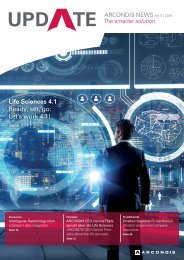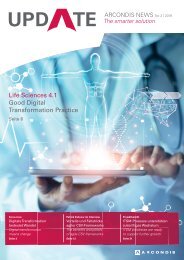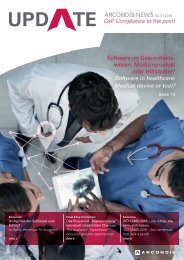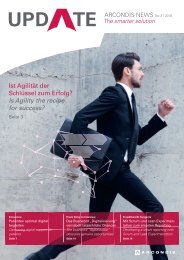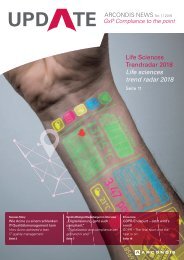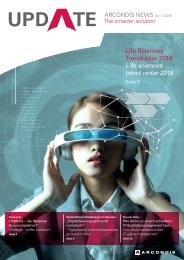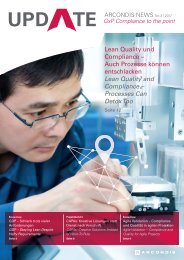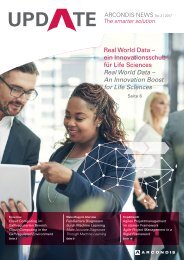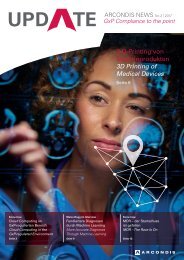ARCONDIS UPDATE No. 03|2017: The smarter solution
ARCONDIS Kundennewsletter für den Themenbereich Business Applications in Life Sciences Unternehmen
ARCONDIS Kundennewsletter für den Themenbereich Business Applications in Life Sciences Unternehmen
Erfolgreiche ePaper selbst erstellen
Machen Sie aus Ihren PDF Publikationen ein blätterbares Flipbook mit unserer einzigartigen Google optimierten e-Paper Software.
12_<strong>The</strong> <strong>smarter</strong> <strong>solution</strong><br />
English<br />
E_Company mergers and splits are constant<br />
occurrences in the life sciences.<br />
<strong>The</strong>y require a restructuring not only of<br />
the organization but also its infrastructure.<br />
During a recent project, <strong>ARCONDIS</strong><br />
demonstrated how to achieve this: when<br />
an international life sciences company<br />
split from its parent enterprise,<br />
<strong>ARCONDIS</strong> took care of the program<br />
management and migration of the entire<br />
application environment.<br />
Starting point<br />
Following the split of a company from its<br />
parent enterprise, a new technical environment<br />
had to be created, from an active<br />
directory domain to the infrastructure and<br />
application environment. <strong>The</strong> life sciences<br />
company entrusted the experienced<br />
professionals of <strong>ARCONDIS</strong> with the task of<br />
migrating all business applications to the<br />
new environment.<br />
<strong>The</strong> most challenging part of the project: its<br />
scope was still uncertain at kick-off. <strong>The</strong><br />
company did not have a central administration<br />
system governing all applications. In<br />
addition, the GxP status of the applications<br />
had to be verified and in some cases<br />
re-evaluated.<br />
Method<br />
Step 1: Establishing an application<br />
inventory<br />
Every migration project needs a clean<br />
database detailing the system infrastructure.<br />
<strong>ARCONDIS</strong>’ first step was to create an<br />
application inventory and establish it as a<br />
“single point of truth” throughout the<br />
company in order to track the status of all<br />
applications for the migration and day-to-day<br />
operations. This involved the classification of<br />
each application. Categories included client/<br />
server, desktop, Citrix and SaaS applications,<br />
and various evaluation criteria were used.<br />
Several important issues had to be clarified<br />
for the migration planning step, including<br />
dependencies on other applications and/or<br />
interfaces and planned life cycle changes<br />
(e.g. due to planned updates, functional<br />
expansions or compliance findings). In<br />
addition, the GAMP category and validation<br />
status of GxP-relevant applications had to be<br />
reassessed.<br />
In total, 400 applications were identified and<br />
classified; 150 of them were to be migrated<br />
within the scope of the project. Approximately<br />
half of the applications are GxP-relevant<br />
and needed to be revalidated.<br />
Step 2: Making the program manageable<br />
During a gargantuan undertaking such as<br />
this, it is important to keep an eye on the<br />
bigger picture rather than focusing excessively<br />
on details. <strong>ARCONDIS</strong> chose a<br />
two-step approach and first established a<br />
rough plan for the individual application<br />
categories. In order to get a better grasp on<br />
the complexity, priorities and scheduling<br />
requirements of the migration project,<br />
<strong>ARCONDIS</strong> developed a multi-level decision<br />
tree. Important criteria included external<br />
access, GxP relevance and whether or not<br />
the individual applications are core applications.<br />
Facts & Figures<br />
■ 2 Mio. Swiss Francs Budget<br />
■ 4500 Users<br />
■ 2000 Clients<br />
■ 150 Applications<br />
■ > 100 Validation Documents<br />
■ 10 Sites<br />
Project Team & Stakeholders<br />
■ 30 Program Team Members &<br />
Supporter<br />
■ 60 Application Manager<br />
■ 20 Vendors<br />
During the second step, a planning project<br />
was initiated for each category to plan the<br />
migration process for each application in<br />
detail. A separate stream was set up for<br />
especially critical applications.<br />
Besides the structure, communication is a<br />
major success factor for programs with<br />
more than 100 participating parties. A<br />
“migration cookbook” was created to<br />
specify the entire program governance<br />
– communication, escalation, risk, issue and<br />
change management, tracking structures,<br />
reporting structures and meeting structures<br />
– and to establish platforms for the exchange.<br />
Thanks to the intelligent planning process,<br />
the enormous endeavor gained structure. Its<br />
hundreds of individual components formed a<br />
manageable whole and a clear, comprehensible<br />
project path was revealed. This<br />
approach was convincing, to such an extent,<br />
that the management decided to expand<br />
<strong>ARCONDIS</strong>’ range of responsibilities. From<br />
then on, the program management also<br />
included the streams for servers, clients and<br />
networks. Program Manager Stefan Eckert<br />
has been responsible for the entire financial<br />
controlling and upstream coordination of the<br />
GxP Compliance ever since.<br />
Step 3: Sequential migration, global<br />
roll-out<br />
At present, the program is close to conclusion.<br />
Approximately 150 applications are<br />
being migrated and rolled out at more than<br />
ten sites. Half of them are GxP-relevant and<br />
subject to revalidation. <strong>The</strong> most complex<br />
part of the project is the sequential transfer<br />
of the entire infrastructure to the new<br />
environment. Once all involved components<br />
have been migrated, integration testing will<br />
help ensure compliance. It involves user<br />
accounts and peripheral devices, such as<br />
printers, that interfere with the application.<br />
To ensure that no component or interface<br />
remains untested, the project team has<br />
developed a watertight traceability matrix<br />
that traces all dependencies.<br />
During the next and last step of the program,<br />
applications that are orphaned or no longer<br />
needed will be disabled.<br />
Results<br />
<strong>No</strong>t only did the program achieve its<br />
objective of a smooth one-to-one migration<br />
to the new environment, it also created<br />
additional benefits thanks to an intelligent<br />
migration strategy. <strong>The</strong> client will continue<br />
reaping these benefits even after the end of<br />
the program:<br />
<strong>The</strong> new inventory records all applications<br />
in a central location.<br />
<strong>The</strong> GxP status of every application has<br />
been determined and all gaps have been<br />
closed.<br />
In order to create synergies, <strong>ARCONDIS</strong><br />
worked with the application owners to<br />
determine the optimal point in time for<br />
life cycle changes and migration process-



